[page=Gameplay]
This text is part of my book"The Hows and Whys of Level Design". It includes the introduction of the Gameplay part as well as the floorplan section of the Multiplayer Gameplay chapter.
My book covers both the visual and artistic side as well as the gameplay aspect of level design. Don’t expect any technical how-to tutorials in the book, this book is about the "why". Rather than writing yet another tutorial/book about how to create a virtual room this book is about how to make that room look cool and play well. Expect tips and techniques as well as explanations of the logic and reasoning behind art and design decisions. How does the gameplay in a level work? What’s the reason this kind of architecture gives this kind of feeling or looks better in situation A or B? Why does this color combination work so well? What kind of floorplan can I best use to improve gameplay and why? What type of sound setup should I use?
More information about my level design book can be found on Book.Hourences.com
Gameplay
The very basics are that there are two types of gameplay in a game: Map gameplay and Core gameplay. Understanding them is fundamental. Many people think of gameplay as just "gameplay" while, in fact, gameplay can be split up into two larger elements: Core gameplay and Map gameplay.
Universal Basics
The very basics are that there are two types of gameplay in a game: Map gameplay and Core gameplay. Understanding them is fundamental. Many people think of gameplay as just "gameplay" while, in fact, gameplay can be split up into two larger elements: Core gameplay and Map gameplay.
Core Gameplay
The Core Gameplay is the gameplay provided by the game itself. It gives the player the ability to spawn, how fast the player can run, if the player can jump and if yes how high and so on. It determines the speed of the game, the weapons and sets the objectives.
A level designer has little to do with this. It already exists and it can't be easily modified by the designer. A level designer's job is to simply accept the Core gameplay and adopt the gameplay of the Map to it as good as possible.
Map Gameplay
The Map Gameplay gives the player the ability to spawn in a world and utilize it by using the Core Gameplay. It provides the player a route to the other teams flag. It determines where the weapons are. It determines what the floorplan looks like. It controls how the Core Gameplay is interpreted!
The Core gameplay defines the overall capabilities within the game, and the Map gameplay gives a place, a location, to exersize these capabilities within.
Map Gameplay needs to augment the Core Gameplay. The word "augment" is the most important aspect of Map Gameplay. There are 10,000 Unreal Tournament maps and even more Half Life and Counterstrike levels out there. Give the player a reason to play this level instead of some other random level. It needs to offer something more than the ability to run and shoot since all the levels out there already provide just that.
The way a designer enhances the Core Gameplay will determine if people like to play the level or not! The Core Gameplay is a foundation to work on. That means that the rest of the house is not constructed yet. It is the designer's job to take that foundation and build it further up until the house is complete. The gameplay in a level should add depth to the Core gameplay.
The most common gameplay mistake is to create a too simple a level which adds nothing to the Core Gameplay. Pretty much every game out there has a box level floating around on the Internet. A big cube where all the players or monsters spawn right next to each other and can do nothing more than attack each other. Such a level or area adds absolutely nothing to the Core Gameplay. The only actions possible in such levels are spawing, attacking and dying. This is exactly what the Core Gameplay provides, the Map gameplay has nothing to do with it. Such levels do not have any gameplay of their own.
Some people find such levels fun, if they do the game designer should be thanked and not the level designer. The level designer failed in doing what he is suppose to do: augmenting the Core gameplay through the Map gameplay environment.
Finding a game fun to play is quite different than finding a level fun to play. It's essential to see this difference as a level designer!
Good Map Gameplay is gameplay that supports and motivates complex strategies and enhances the depth and the fun through the use of a dozen elements such as: traps, differences in height (vertical gameplay), planned and balanced item placement, extra small stories, puzzles, etc.
An example of this are liftjumps; the player can jump higher by using the momentum an elevator provides. The Core Gameplay has nothing to do with that. It is the level that offers the possibility. Without Map gameplay all levels of a game would play the same. If a map doesn't add enough to the Core it fails as a level, gameplay-wise.
Never work oneself to death on just gameplay or just graphics. Only the perfect combination and harmony between each aspect can bring about a good game experience. Graphics are made to support the gameplay while the gameplay is made to support the graphics! One must support the other. A scary monster setup needs specific environmental elements to function well and the other way around a scary environment also needs a scary monster setup to work well. In a world where gameplay is increasingly split from the visual side I feel that this is often forgotten.
Artists usually have very little understanding of gameplay mechanics and gameplay designers often have no artistic insight. The result is that both implement their own vision in the environment and work divergently instead of working together. Don't make the same mistake. One can't exist without the other.
Multiplayer
Basics
Gameplay in games, and especially in fast paced multiplayer games like Unreal Tournament or Quake, is often misunderstood. Most people think it is only about running around and shooting large guns in order to see as much blood as possible. It is not.
If players play well it approaches a 3D variant of chess wrapped up in a package with weapons. One tries to predict the enemy's next move.
The level must support and stimulate this; and that’s exactly the point of gameplay in multiplayer levels. Far too many people create really simple floorplans and make no use of extra features. Why would a player choose this level over someone else's if they have a choice? What does this level offer that others don't? How does this level add more depth to the game?
Floorplans
So how do floorplans fit into all of this?
A floorplan should offer great flow and the ability to use the level against an enemy, in other words, strategic potential. Offer the player the ability to think. A few rooms with only a few corridors or connections in between is, in most cases, not enough for the simple reason that it adds absolutely nothing to the core gameplay. It must offer more depth and potential.
A floorplan should keep flowing around. Try to minimize the amount of rooms with only one entrance/exit or long boring hallways. Make it to the point, keep the speed and the possibilities in it and give it depth. All of these requirements will be addressed later on.
If one has to ask oneself the question how to get back to room X while playing the level, then it lacks flow. A player should be able to end up everywhere without thinking about where to go. A level should have such good connectivity that the player gets dragged along and sees the entire map just by walking forward, in a manner of speaking.
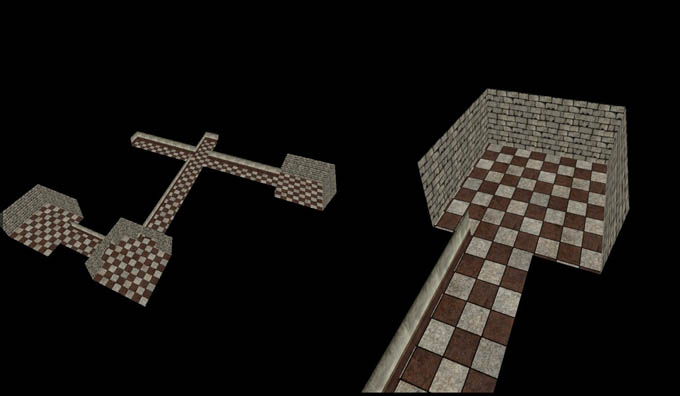
Info P007: Example – Personal work – Owned by myself -- P008: Example – Personal work – Owned by myself
Here are two bad examples: Long corridors and several dead ends. These both leave little choice of where to go and what to do. There is only one way in and out: it is a trap.
Anyone who enters it will be trapped when an enemy shows up. There's no reason at all for a player to enter such a dangerous trap. Unless
there is something in that room that rewards the players for the risk, they won't enter it.
Although the situation in following example improved it still isn't perfect.
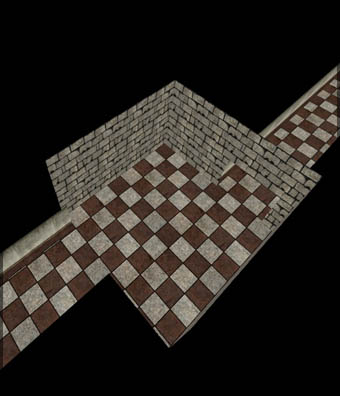
Info P009: Example – Personal work – Owned by myself
Now there are two ways out and that still is not good enough. How can a designer offer the player strategy and freedom of choice when there are only have two exits/entrances? When an enemy shows up while the player is in the room one can only use the opposite exit/entrance the enemy used. There still isn't really a choice and thus the player's direction will be very predictable. That’s not strategy.
The best situation is to have three or four exits. Like in following example.
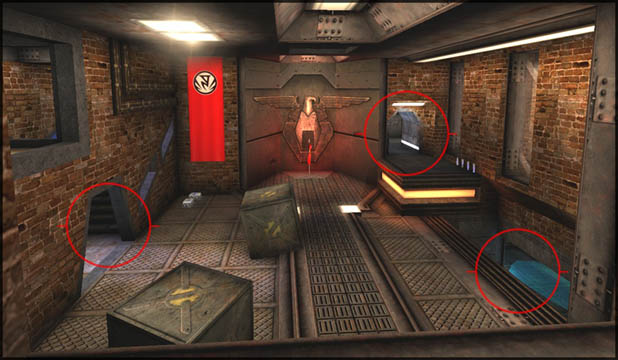
Info P010: UT level CTF Raid – Personal work – Owned by myself
Why is this better? Because there are multiple ways in and out. It flows, the players are offered enough possibilities to allow them to make their own decisions and choices instead of being forced into a single corridor.
Rooms are often connected by corridors which can lead to other problems.
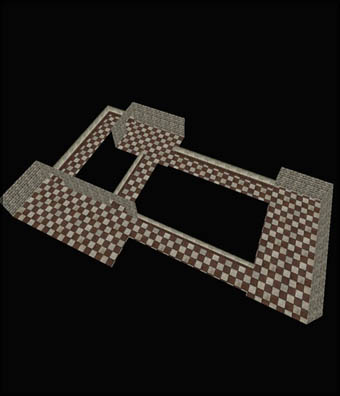
Info P011: Example – Personal work – Owned by myself
In this example the corridors are way too long which is bad.
The result is a.) really straight-forward gameplay b.) lots of boring running and c.) the player is trapped inside a corridor which results in the same problem as the room with only two exits: the player has only one way to go when an enemy shows up and when attacking might not be an option when one is low on health or armor or when the enemy has the superior aim, for example.
The endless corridor syndrome is often given the abbreviation RCR: Room-Corridor-Room. Try to avoid using this layout unless it is required by the core gameplay.
Try to make sure the corridors aren’t too long and that they add enough connectivity by, for example, having another corridor intersect with the main corridor. A hole in the floor is another possible option. The following examples shows how a long corridor can be intersected by another corridor to give the players more possibilities.
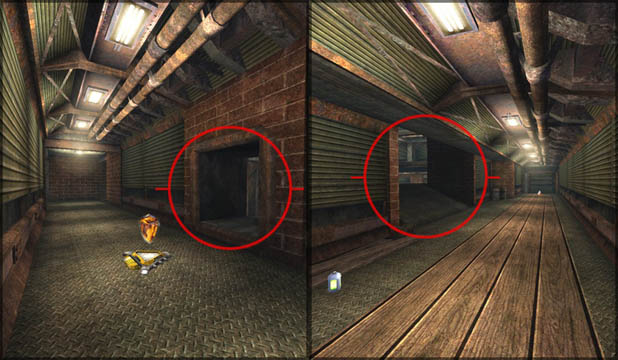
Info P012: UT2004 level DM Rankin – Personal work – Owned by Epic Games
A long corridor could work very well in singleplayer or specific multiplayer gameplay but in most multiplayer scenarios and especially in the standard Deathmatch and Capture The Flag situations one is better off preventing it unless it will be exploited as a danger zone. See the item section for more information on that.
Another common mistake is creating too large and open areas. The exception to this rule are of course large scale outdoor games such as Battlefield.
However, in most other games and especially in hardcore shooters such as Half-Life, Quake or Unreal Tournament one wants to prevent creating rooms and other areas that are very large and open like following example.

Info P013: UT level DM Liandri – Created by Epic Games – Owned by Epic Games – Modified version to fit the example
The problem is that there's an over-reliance on the core gameplay and aiming. Since the enemy can always see the player he can easily predict what the player's going do or where he want to go.
Open areas -> the player can only jump around and attack -> repetitive -> predictable -> boring
Such gameplay relies purely on core gameplay and on aiming skill and that's not the goal. If aim is the only skill that matters in the game, mod, or level the gameplay will be overly simplistic. Close off and break up areas.
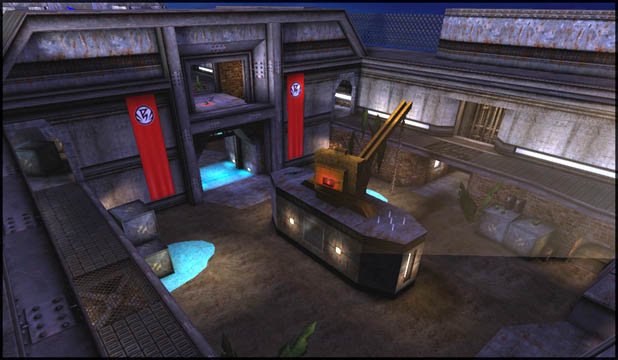
Info P014: UT level CTF Raid – Personal work – Owned by myself
In this example one can see the outdoor connection between two Capture The Flag bases. Instead of a simple and flat sandy area, there are two walkways, two elevators, a large building in the middle, several large crates, and a crane to close off areas.
As already described in the Design chapter, an often forgotten but important aspect is to make sure the floorplan supports the visuals and technical requirements. When I design a floorplan I keep the visuals and technical requirements in mind at all times.
Both the visual and technical elements are very important when a floorplan is designed. Certain rooms, such as large open cubes with catwalks in it, are much harder for an artist to fill in successfully, demanding much more time and effort. Why not make it easier? A well designed
floorplan will not only help gameplay, it will also help the visuals and even the framerate. An issue might be that a floorplan is so open
that it becomes impossible to optimize with occluders.
The point is that some types of shapes and sizes can make it easier, or harder, for an artist to turn something into a nice and well optimized
area. If you're not the person who will create the visuals be sure to talk with him. If you will also create the visuals try to imagine how
the visuals will work out in the floorplan you just created. How will the room be filled up? What kind of architecture and lighting will fit
it ? What kind of changes would make the room easier to fill up with detail? Perhaps it would look cooler if the ceiling was higher?
Everything must be in harmony. Remember things are created to work together - not independent of each other.
Therefore having knowledge of every aspect of level design is a must, even when one's task is to only create the floorplans. This is another
reason why I am not fond of splitting up level design between too many different designers and artists.
yea nice work :)
Thanks, makes tons of sence when you say it. But i guess i never thought about it. Thanks again mate.
Really nice stuff. It helped me tidy up the sky of floating feel for level design that I have inside my head :) Thank you for taking the time to do this.